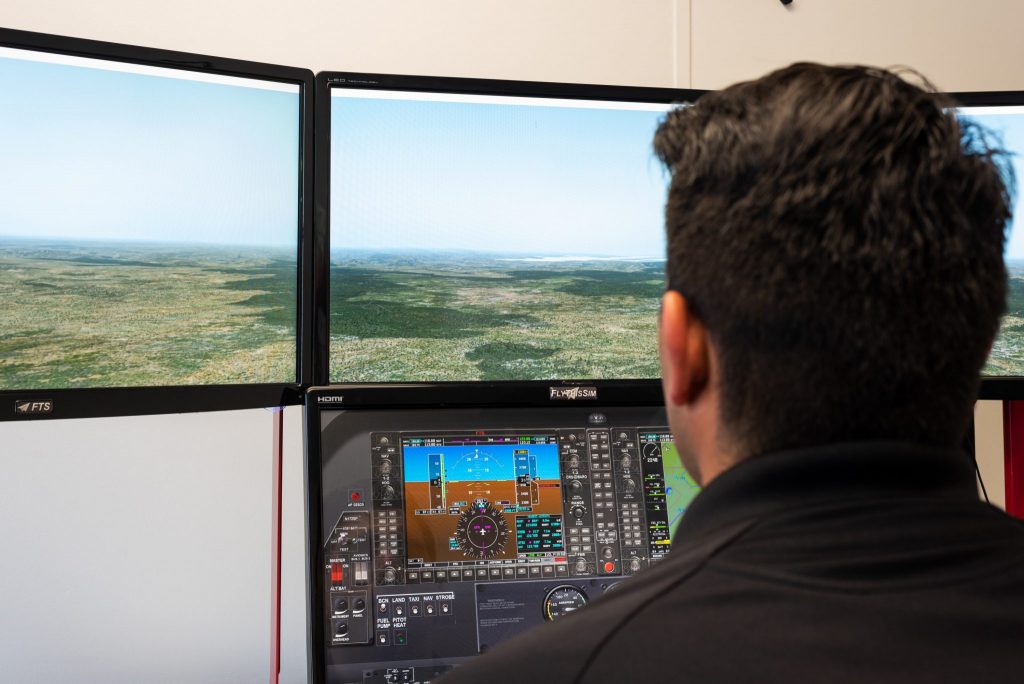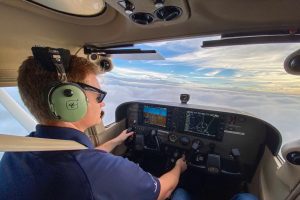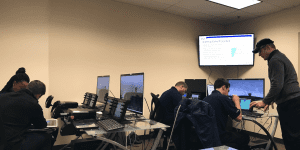Skift Take
As the travel recovery looks to ramp up for summer travel, a pilot shortage isn't helping any. The time to invest in pilots is at the pilot training level by making it easier to get loans, financing, and scholarships.
A Texas educational lending company and a California flight school are teaming up for a new initiative with the promise to make flight training more affordable and accessible and thereby help reduce pilot shortages in the United States.
The partnership between San Diego-based Coast Flight Training, a military veteran-owned flight school training future airline pilots, and Meritize, a lending company specializing in financial solutions for skills-based education and training, makes student pilots at Coast Flight Training eligible to apply for Meritize’s merit-based financing based on their past military and educational experience.
“We evaluate people based not just on their credit profile, but on what they’ve accomplished either academically or in military service, or in some cases what they’ve done in terms of work history. And we take that heavily into account,” said Chris Keaveney, CEO of Meritize.
Meritize, which was founded on the premise that there was a really big problem with providing people access to training that could change their lives, only works with schools in non-traditional spaces, where financial access is traditionally worse, Keaveney said.
Semper Fi
Coast Flight is owned by its CEO, Bryan W. Simmons, a retired Marine lieutenant colonel who flew helicopters in war zones, Marine One for former President George W. Bush and taught fixed wing aircraft flying at the Navy flight school in Pensacola, Florida. The school is transitioning from a small boutique flight training to a more formalized academy-type training.
Simmons said the school is able to leverage its flight training capacities and capabilities in training people through a whole spectrum of ratings in what he calls “zero to hero” into partnerships with airlines.
American Airlines partners with Coast Flight Training for its cadet academy, another program the school offers to train pilots exclusively for American. The Dallas-based airline said it remains in close contact with Coast to ensure a seamless transition from selection into the program to for its students.
While American said it has not experienced any pilot shortages, the airline emphasized the need for a larger, diverse group of well-trained students and instructors remains a priority for the flight industry.
“Although there are many flight schools that train exceptionally well, it’s important that training is done efficiently. Our flight academy partners are both efficient, safe and expeditionary by nature, meaning they quickly and skillfully move to gather resources as needed throughout the training process. Aircraft and seasoned instructors are vital to the mission, and our flight training partners have both,” said Whitney Zastrow, spokesperson for American Airlines.
Coast Flight has two Texas regional offices in San Marcos and South Dallas, a predominantly African American community and is in a good area to offer training to their communities and increase pilot diversity, Simmons said.
“The concept between Coast Flight Training and Meritize is to be able to reach more people. One of the difficulties in flight training has always been its kind of a niche training. You can get all kinds of loans for a four year college, for whatever degree it is, whether it’s meaningful or not, or you’re just hanging out in college and you can drive up your loans to a ridiculous number and no one seems to question it,” Simmons said.
He said traditionally it was either that there was none of that available, it was mom and dad with a home equity line of credit, or some creative ways to pay for flight training, or high interest credit cards type of situations, or people would work five hours to be able to pay to fly one hour. But that last method takes two or three years.
Cynthia Hernandez, 26, a San Diego-based flight instructor at Coast Flight Training, said she wishes an initiative with Meritize had existed while she was a student at the school. Instead, the aspiring American Airlines pilot, studied at San Diego State, applied for scholarships with organizations like Women in Aviation and the Envoy cadet program. She also worked part-time and had help from her parents in order to pay for her flight training before being accepted into the Envoy cadet program that guarantees her a job once her flight hours are reached, she said.
Hernandez who has wanted to be a pilot since seeing planes taking off at the Marine base where she was a lifeguard, applied to Embry-Riddle and received scholarships to attend, but the costs were 10 times more expensive, she said.
“I got maybe $50,000 for Embry-Riddle, but that wasn’t close to covering anything and with $50,000 at Coast that could pretty much get you to your commercial (rating),” Hernandez said.
She flew for a while with another flight school before transferring to Coast Flight’s very structured syllabus program that let her know what her next event was and allowed her to get through the program quickly and efficiently, Hernandez said. She also enjoyed the smaller classes that allowed for group studies.
Hernandez, who said she enjoys teaching, plans to remain flight instructing at Coast for a little longer before flowing into Envoy and then flowing into the majors with American after that, she said.
Broadly, the gap between student loan dollars and the actual cost of training presents a huge barrier of entry to the career path. When student loans don’t cover the total cost of training for a career, those without wealth or access to private capital are excluded. Today that is the reality for pilot training, said Faye Malarkey Black, president and CEO of the Regional Airlines Association (RAA).
Training can cost anywhere between $85,000 at the low end for a non-degree program, and $200,000 or more for a two year or four year degree program, she said.
“First of all finding a lender that is happy to provide funding when there is no guarantee that the individual will succeed at pilot training – that is one issue. Second is taking on the considerable debt and realizing that initial pay as a First Officer can be fairly low,” said Bill Whyte, vice president of aviation operations and technical services at the RAA.
What Meritize is able to do is they focus on this and understand the industry as well as the need and they’re basically setting the student up so they can have access to a good amount of money. And in short amount of time understanding that this student, if successful will go on to the airlines and be able to pay back the loan in short order, but the compensation on the back side is a bet well taken, Simmons said.
Grit to Be Successful
“We can help people that other people are going to say no to. And it’s obvious to us why we can, it’s because they have demonstrated that they have the ability and the determination and the grit to be successful,” Keaveney said.
One thing Simmons liked about the Marine Corps is that they kind of forgot the past and said let’s go ahead and start proving it. Which is a lot of what Meritize and his flight training component is, said Simmons,
“It’s like whatever that may look like for you or whatever happened in life, here’s the deal, this is a technical trade we’re entering and we’ll give you an opportunity to prove yourself,” Simmons said.
While the pandemic appeared to give the pilot shortage a reprieve, the problem still exists.
The biggest issue in the airline pilot shortage is the lack of trained pilots and encouraging people to come into the industry due to the financial constraints, said Whyte. Another issue he said is finding and keeping qualified instructors to train students in flight schools and check airmen in regional airlines, which are the first to be hired by the major airlines.
Whyte said if a training school is looking at military veterans that is good, he emphasizes it’s just one small part and hundreds of (schools) need to be doing that to keep the pipelines fed, he said.
“Obviously the pandemic set us back a little bit, but what you are going to see on the frontside is this pilot shortage is really excessive. The recovery for pilot shortage got stymied by two to three years because they let a bunch of senior pilots go who all had two or three years of eligibility and they all took early retirement,” said Simmons.
And you can see for the airlines these weekends are filling up pretty quickly and you’re going to start seeing flights cancelled because the pump that was producing pilots, it was running at a steady stream and now it just got errant. So it’ll take some time to prime that pump and get folks training, Simmons said.
“By the third or fourth quarter of 2021, we anticipate U.S. carriers will start feeling the shortage – initially and most acutely with the regional airlines,” said Geoff Murray, a partner in Oliver Wyman’s transportation and services practice, and author of the recent study, “After Covid-19, Aviation Faces a Pilot Shortage.”
Murray, who was previously a pilot, said the impending shortage is being amplified by the number of early retirements during the pandemic, but also because of the pace of recovery in certain segments like domestic travel.
“Combined these dynamics create significant additional training demands across an airline which must be met before pilots are certified on particular equipment. To put it into perspective, some (airline) training programs can be as long as eight to ten weeks meaning pilots are not out productively flying planes with passengers,” Murray said.
Simmons said airlines are now in a position that puts high school kids at a crossroads of which road to take. Left or right go to college, then flight training and becoming an airline pilot? Or go straight from high school into flight training, he said.
Because flight training is a vocational school, Simmons said being a pilot is really a trade with a certain set of skill sets providing white-collar pay levels and ability to grow. And that makes it really interesting for students coming out of high school, or someone who’s spent a year in the mix at school and really wants to become a pilot, he said.
Flight training offers students the ability of being intensively trained in 12 months and when they have reach the required 1,500 flight hour for an airline pilot, Coast Flight can introduce them to all the regional airlines so by the time they’re 22 or 23 years-old, they’re flying as a first officer in the airlines and that’s a totally different mindset, Simmons said.
While military veterans who qualify can use veterans administration funding to pay for training, Simmons said it’s probably not the most effective use of their Post 9/11 benefits. He recommends veterans get their flight training using other means and then use their veterans’ funding to go to college after becoming a regional pilot to round them out as a whole person, so they’re not a one trick pony, he said because things happen and you want to have something to fall back on.
Meritize has developed analytical methods to look at what people have accomplished in their military service and is reflected on a veteran’s DD-214 or military discharge papers, which Keaveney likens to a college transcript. Meritize uses that information to get comfortable that veterans are going to be successful at what they’re trying to do, he said.
For example, if two people with a 700 FICO apply for financing, but one of them served in the military and can have their DD-214 evaluated, Meritize can offer both credit to get trained, but the veteran who had their experiences looked at will probably receive a more favorable loan including better terms and lower interests based on the credits for accomplishments, said Keaveney.
Veterans have all the qualities Coast Flight look for. They show up to work, can pass a drug test, have a respect of authority and chain of command and are used to being trained in a systematic way, said Simmons. Aspiring pilots can come out of the military at 50 years-old, get flight training and still have about 13 years to fly before mandatory pilot retirement at 65, he added.
Coast Flight is typically seeing high school students, transitioning military helicopter pilots, veterans transitioning from the military looking for a second career and folks coming from colleges, Simmons said.
Looking for Right Attitude
One kid was graduating in neuroscience and went into flight training because Simmons said it was something that wasn’t resonating with the student.
“We’re just looking for that right attitude, aptitude and ability. It’s really what makes it,” Simmons said.
In addition to working closely with American’s cadet academy, Coast Flight has training partnerships with Skywest and American Airlines regional carriers, Envoy, PSA and Piedmont, Simmons said.
“Coast Flight’s team members, from the instructors to the site director, know each student by name, know how each individual learns and faces challenges differently, and celebrates the students’ achievements alongside them — highly important qualities for a flight school partner, ” said American’s Zastrow. “We want our cadets to build lasting relationships with their teachers and classmates that spark long, enduring mentorships and friendships they can lean on throughout their journey as a cadet and, eventually, an American Airlines pilot.”
The pandemic caused a disruption in transitioning American’s first Coast cadet class, who are now expected to start with an American regional partner in early 2022, Zastrow said. The joint program between the airline and the flight school launched in 2019 and follows a 12-month training regimen with an additional 18-months of flight hour building, she said.
“I see the pilot shortage returning much sooner than many analysts predict. While there remains some question about when demand will fully return, pilot hiring is most effective when it is anticipatory. There is a long lead time on pilot hiring,” said RAA’s Malarkey Black.
“While there is uncertainty, airlines are planning for demand to return. This means that the timing of pilot hiring won’t be after demand returns — it has to be timed so that the pilots are in place to meet that demand when it arises,” she added.
United is planning to hire approximately 10,000 pilots by 2030 and train half of that amount at its own United Aviate Academy. In the immediate future, United will be bringing on an initial 300 pilots hired in the coming months, a spokesperson said.
American is planning on hiring 300 pilots this fall to onboard by the end of the year and 600 pilots in 2022, said Captain Chip Long, vice president of flight operations at American in a memo to all its pilots.
Simmons said being a pilot is a directed, high-paying job and rewarding career, He believes it opens the door for a lot of people that have never had that opportunity to have that door open.
The Daily Newsletter
Our daily coverage of the global travel industry. Written by editors and analysts from across Skift’s brands.
Have a confidential tip for Skift? Get in touch
Tags: airline pilots, airlines, american airlines, coronavirus, coronavirus recovery, pilot shortage
Photo credit: A commercial pilot-in-training checks the plane at the flight line. Photo courtesy of Coast Flight School / Skift


